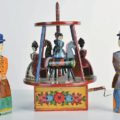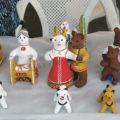There are many toy crafts on the territory of Russia: mainly they are located in areas with rich resources of wood and clay and many skilled carvers or potters. Such craftsmen made the everyday items needed by their families and produced some for sale as well and they used the leftover materials to make toys for children. For example, a craftsman hewed a trough from a wooden blank, and from the piece that was left over, he carved a toy horse for his son. Sometimes these crafts were even more successful than the main production items: craftsmen started to make them specifically for sale at fairs. Gradually the production of toys developed into a separate industry.
Living clay
Clay toys, especially clay whistles, were very popular in Russia. Scientists believe that initially such whistles were made not as toys, but as a protective amulet: the whistle drove away evil spirits. Over time, a simple whistle turned into a full-fledged musical instrument: craftsmen began to make toys with more air capacity and added sound holes on their sides. By alternately covering the holes with your fingers, you could perform real, albeit simple melodies. Most often, the whistles had a recognizable shape of a lamb, crane, duck, or rooster. And sometimes they had all these shapes at once. For example, toys from Khludnevo are big impersonators: you look from one angle, it is a bird, from another — a deer’s head, and from the third side — a flower!
Each region of the clay toy industry has its own manner of shaping and painting. This is understandable because in different regions the clay differs in color and texture. For example, blue clay in the village of Filimonovo, famous for its toys, cracks during work. The craftsmen smooth these cracks with damp fingers, and that is why even the usual cows and horses have a thin elongated body and a long neck. After firing, blue clay becomes pinkish-white: it is convenient to paint it with bright colors. In the village of Pleshkovo in the Oryol region, there is an unusual clay with particles of mica and that is why the traditional Pleshkovo toy shines beautifully after firing. In order not to ruin the effect, the masters used only a minimal amount of paint. But the Dymkovo toy, on the contrary, is very bright. It is molded from red clay mixed with river sand, and after firing it is whitewashed — today with tempera whitewash, and earlier it was with a mixture of chalk and milk. The toy is painted with rich red, yellow, blue, and green on a white background. The cheerful Dymkovo ornament is part of the cultural code of Russia, it is for a reason that its motives were used at the opening ceremony of the Olympic Games in Sochi.
Dymkovo toy
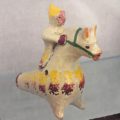 These toys in modern times are still made by a craftsman from start to finish. Researchers notice that the toys of an artist or another somewhat resemble their makers. Dymkovo toys are usually divided into mass production and exhibition toys. The mass production toy is close to the original forms of the 19th century: simple figurines painted with traditional patterns. The exhibition toy reflects the author’s fantasies and experiments with form and color.
These toys in modern times are still made by a craftsman from start to finish. Researchers notice that the toys of an artist or another somewhat resemble their makers. Dymkovo toys are usually divided into mass production and exhibition toys. The mass production toy is close to the original forms of the 19th century: simple figurines painted with traditional patterns. The exhibition toy reflects the author’s fantasies and experiments with form and color.
Wooden fairy tale
Russia has always been famous for its carpenters and woodcarvers. Sometimes their skill was so amazing that bystanders suspected there was some kind of magic. For example, in Gorodets they said: “To make a gurney, you need to know the demons.” The gurney is a horse on wheels. To make it, Gorodets craftsmen carved out more than 30 parts and drilled holes for them with jewelry precision — the toy was made without a single nail nor glue! They also made other toys in Gorodets: young ladies, soldiers, and animals, and often these toys had wheels. The typical decoration of the Gorodets toy is a bright multicolored painting with lush roses.
The counterparts of Gorodets craftsmen from the village of Bogorodskoye, in contrast, did not paint their toys. But they knew how, with the help of a special knife and file, to make soft linden wood look like porcelain, and, if necessary, to transfer the texture of fur, grass, or feathers on the wood. The most famous Bogorodsk toy are the “Blacksmiths”. It is mechanical: you pull a special lever-bar and the man and the bear take turns pounding on the anvil. The toy is so popular that it even adorns the modern coat of arms of the village of Bogorodskoye. The toy “Chickens” with a balancer was played back in the days of Alexander Pushkin and Mikhail Lermontov: one movement of the hand — and the birds begin to peck at the grain.
Gorodets and Bogorodsk toys are a ceremonial type of wooden toy. They have always been made for sale but beautiful interesting toys could be found not only at fairs. And not just in central Russia. For example, in many houses in the Arkhangelsk region in the 19th century, there were birds of happiness or, as they were also called, Pomor doves. For example, Mikhail Prishvin wrote in his book: “I am in the clean room of a well-to-do Pomor. In the middle of the room hangs a dove, carved out of wood and painted in gray paint. There is a legend that the first such a dove from a block of wood was made by a peasant whose son was seriously ill. The father was weaving a basket and told the boy that summer would come soon, flowers would bloom and birds would sing. Following the story, the master’s dexterous fingers folded a bird out of wood chips. He hung it over his son’s bed and from that day on, the child began to recover. By the way, the character of the legend is the basket-maker for a reason. It was the basket-makers who knew how to skillfully split wood into thin slivers, from which the body and wings of a bird were folded, carefully spreading each feather. The thinner were the slivers, the more delicate the work would be.
Matryoshka
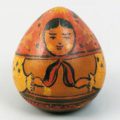 The first doll was made by the artist Sergey Malyutin in the 1890s, based on the figurines of the Japanese Seven Gods of Happiness, which were placed inside each other. Malyutin immediately got the idea to make a similar item in the Russian style. The first Matryoshka had eight figures. But in 1970 at the Semyonovskaya Rospis factory they made a set of 72 dolls, each with its own unique pattern. This Matryoshka was recorded in the Guinness Book of Records.
The first doll was made by the artist Sergey Malyutin in the 1890s, based on the figurines of the Japanese Seven Gods of Happiness, which were placed inside each other. Malyutin immediately got the idea to make a similar item in the Russian style. The first Matryoshka had eight figures. But in 1970 at the Semyonovskaya Rospis factory they made a set of 72 dolls, each with its own unique pattern. This Matryoshka was recorded in the Guinness Book of Records.
Patchwork girlfriend
The Russian rag doll can be called a toy only conditionally, so seriously was it taken in Russian villages. Such dolls were made from scraps, stuffed with straw, grains, or a mixture of ash and water. Traditional Russian dolls have white faces: neither eyes nor mouths was painted on them. What if the line goes crooked and then the doll has a bad temper? People never made the patchwork dolls for sale but only for themselves. For making these dolls only old clothes were used: here is a piece of father’s shirt, there is a piece of grandmother’s skirt. And the doll was perceived as part of the family: how can you give it into the wrong hands? When a girl got married, she would take her dolls with her. If you remember the plot of the Russian fairy tale “Vasilisa the Beautiful”, it becomes clear why. There, the doll is the assistant and protector of the main character against the wiles of the evil stepmother. Even when everything ended well, and Vasilisa married the tsar, she “carried the doll-helper in her pocket for the rest of her days.” Sometimes dolls could be presented as gifts. For example, in the Kaluga region, a man who was unsuccessfully courting a girl could give her at a gathering a rag doll-changeling specially sewn for this occasion: a beauty on the outside, and if turned inside out — an old woman! Herein is the subtle hint not to brush aside suitors.
Of course, in the era of Lego and Barbie dolls no one plays with wooden horses or clay whistles. The Russian folk toy has lost its practical meaning but has turned into an artifact that connects the present with the past. These toys are exhibited today in ethnographic and historical museums, and in many of their workshops you can try your hand at being a craftsman: pick clay or a piece of wood and make your own toy, just like hundred years ago.
Lovebird dolls
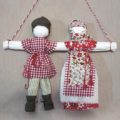 They symbolize the unity of a young family: it’s for a reason that the dolls have one shared hand. Traditionally, lovebirds are made without any cutting tools, what if suddenly family happiness is cut off? Pieces of fabric from the canvas are torn off, not cut off, and a whole thread of life-affirming red is used for binding. The amulet is kept throughout life. But if the doll is broken, you can make a new one. For example, for a wedding anniversary.
They symbolize the unity of a young family: it’s for a reason that the dolls have one shared hand. Traditionally, lovebirds are made without any cutting tools, what if suddenly family happiness is cut off? Pieces of fabric from the canvas are torn off, not cut off, and a whole thread of life-affirming red is used for binding. The amulet is kept throughout life. But if the doll is broken, you can make a new one. For example, for a wedding anniversary.
Tatiana Borisova

